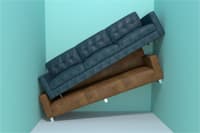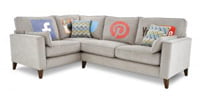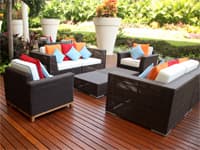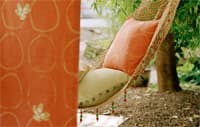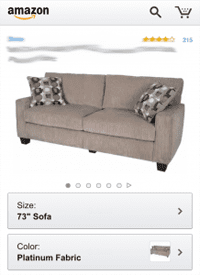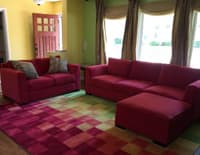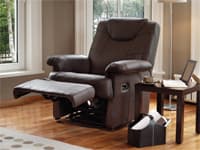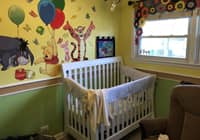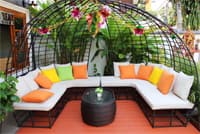
Consumers Posts
Understanding consumer trends is an important part of running your business, even for wholesalers. Keep on top of consumer trends by following the Factoring 101 Blog.
Jump to a Post
Living Rooms are the Most Popular Room for an Area Rug
While area rugs are becoming increasingly popular and can be found all around the house, they are most commonly found in living rooms. 44% of all homes have an area rug that is 5-by-8 or larger in their living room, making it the most popular room in the house for a rug. Living rooms are followed by master bedrooms, which feature a large area rug 20% of the time, and by dining rooms, where you can find an area rug 19% of the time.
You will see an area rug in a family room or den 13% of the time, however among affluent households who make more than $100,000 a year, that figure rises to 25%. Children's bedrooms contain area rugs 9% of the time, and it should come as no surprise that this figure rises to 18% among Millennials who are most likely to have children living at home. Only 8% of kitchens, 6% of guest bedrooms, and 4% of home offices feature area rugs. 6% of other rooms have area rugs, this includes play rooms, bathrooms, hallways, laundry rooms, sun rooms, outdoor rooms, closets, and more.
When it comes to colors, browns and beiges are the most popular accounting for over a quarter of all rugs. Blacks and grays come next accounting for a little more than a fifth of all rugs. This is followed by blues and purples which account for a seventh of all rugs and multi-colored rugs account for an eighth of all rugs. Greens, reds, and whites each account for about one in twenty rugs. Yellows and golds are slightly less popular than one in twenty, and oranges only show up in about one in fifty rugs.
As for shape, a whopping 90% of all area rugs are rectangular. Runners account for only 4% of the rug market. After that only 3% of rugs are circles, 2% are squares, and 1% are oval.
When it comes to shopping for area rugs, online is the way to go. Seven in ten consumers shop online while only a little more than four in ten consumers will visit a brick and mortar store. Of those who shop online, four in five consumers will compare prices with most preferring to do so with online-only retailers. A quarter of consumers will spend less than a week researching rugs before making a purchase. A fifth will spend up to two weeks before making their purchase, and another fifth will spend three to four weeks researching before making a purchase.
If you are a rug manufacturer or importer and could use some help financing as you grow your business, look no further than DSA Factors. Unlike banks, we make decisions based on your customer's good credit, not your own credit. And we spend minutes, not months, to make decisions. Other advantages to factoring include unlimited potential for funding, so as your business grows so does the amount we can fund you. We also offer purchase order financing if you need help getting a container released or starting production on a large order.
The Benefits of Online Sales
As a manufacturer you may think that online retailers are simply another retailer who you can sell your product to, however, there may be a lot more to an online sale than just the sale itself. It's quite possible that making one online sale could lead to many more sales both online and in brick and mortar stores. The reason for this is because of the importance that consumers place on online product reviews.
When consumers use their phones to go shopping at home or on the road, you may be surprised that the most common things that they look for our store locations and hours. That's right, 75% of internet users at home and 80% of internet users on the road want to find a brick and mortar store to shop at. Other popular uses of the internet include some more obvious benefits such as comparing prices, looking for coupons, making actual purchases, checking on the status of orders, and of course reading product reviews.
Of course, once these consumers get to an actual store their use of the internet changes. Once in the store the most popular use of the internet is searching for and redeeming coupons, an activity that 55% of smart phone owners do. 51% of smart phone owners will compare prices at other stores to make sure that they are getting the best deal. Then the next most popular activity is looking at product reviews which is done by 47% of smart phone owners.
Over three-quarters of Millennials and Generation Xers state that product reviews are very influential in the decision making process when purchasing something. Nearly six in ten Baby Boomers feel the same way, and almost half of all seniors also take consumer product reviews very seriously. Of course these product reviews are online, and the only way you are going to get them is if your products are available from online retailers.
While it is true that anyone can write a review of a product online, what makes a review most valuable is that it comes from a verified buyer, meaning that a person bought the product from the same online retailer that they are writing a review on. If you look at reviews on Amazon, you will notice that many of them will say "Verified Purchase" meaning that the person who left the review purchased the product on Amazon. While it may not be important to consumers that a product was purchased on Amazon, it is important that the writer of the review actually did purchase the product, and isn't just someone in the manufacturer's office trying to brag about how great their product is to improve sales.
Other important features on reviews are the amount of detail included in the review, the more detail the better. If you reviewers include pictures then the review can become really influential. Also, consistency is very important as well. If five different reviewers say the same thing about a product, then it must be true.
Of course, as a manufacturer it may seem like all of these factors are out of your control, it is up to the consumer, whom you do not know, to leave a review out of their own good will. However, in many ways you do have control when it comes to leaving reviews. First you need to make sure that your product is available online so that consumers can leave reviews of it. Of course, it can't just be available from any online retailer, it has to be available from reputable online retailers where consumers look at reviews such as Amazon, Wayfair, Target, and Walmart.
Another option is to offer an incentive to consumers who leave you a review. One way of doing this is by offering consumers a chance to get a free product for leaving a review. Ask consumers to fill out a registration card that asks for their Amazon profile so you can see the review that they left for your product, as well as other products. Then select several consumers who gave valuable detailed reviews on both your product as well as other products to receive a free product. You can also look at how many other people found these reviews helpful as these are people who are highly influential in others purchasing process. You can assume that the recipients of the free product will also leave you a quality, detailed review on this free product as well.
If you need to start selling to online retailers, or need to start offering incentives for leaving product reviews and find that some improved cash flow will help, why not try accounts receivable factoring. At DSA Factors we make solving your cash flow problems easy by funding you for your receivables the same day your merchandise ships. You no longer need to worry about waiting 30 days or more to get paid for a large order, so what are you waiting for, call us at 773-248-9000 and start factoring today. At DSA Factors we have money to make your company grow.
The Living Room is the Most Popular Room to Redecorate
A recent survey of over 1000 consumers found that when it comes to redecorating a home, the living room is the most popular room to get updated. The first thing consumers will do when updating their living room is to purchase a new sofa, in fact most other furniture purchases are based around the purchase of the sofa. After selecting a sofa, consumers will then purchase other furniture and accessories that compliment their new sofa.
Six out of ten consumers will purchase the sofa first when redecorating. After purchasing their sofa they will then typically purchase new entertainment furniture and an area rug. Occasional tables, lamps, and decorative accessories are also popular purchases for the living room. When it is all said and done, the average consumer will spend in total $2200 on furniture for their living room. Baby Boomers spend the most on living room furniture, on average about $3000. Generation Xers are next, spending $2500 on average, while Millennials only spend about $1500 on average.
Living rooms are the top choice of rooms in the house to redecorate for any generation, but this is especially true for Millennials and Baby Boomers. 42% of Millennials plan to update their living room first, which is twice as many as plan to redecorate their master bedroom, the next most popular room in the house to redecorate. 38% of Baby Boomers plan to redecorate their living room first, which is more than twice as many than those looking to redecorate their master bedroom. Living rooms are still the most popular for Generation Xers, but beat out master bedrooms by a narrow margin of 32% to 26%.
When it comes to redecorating other rooms, on average consumers will spend $1500 on furniture for their master bedroom. Kitchens are the next most popular room to redecorate, approximately 12% of consumers plan to redecorate their kitchen next and on average will spend $5000 on doing so. Other popular rooms to redecorate are home offices and additional bedrooms for Millennials, while the older generations plan to redecorate family rooms and bathrooms.
If you are a furniture manufacturer and are hoping to get more business from consumers looking to redecorate but don't have the working capital needed to do so, have you considered accounts receivable factoring? With accounts receivable factoring you don't assume any new debt, instead you get paid today for your invoices that aren't due for another 30 or 60 days. You can then use this improved cash flow to attend trade shows, develop new product lines, or do whatever else you need to grow your business. To learn more about accounts receivable factoring give DSA Factors a call today at 773-248-9000 and you can get funded for your receivables in as little as 24 hours.
Quality and Durability Most Important When Purchasing Home Furnishings
More than nine in ten consumers state that quality and durability are important when purchasing a sofa or any other home furnishings. On average consumers expect to keep a new sofa for ten years. Mattresses are almost kept as long with the average consumer expecting it to last nine or ten years. However, area rugs have shorter lifespans, usually getting replaced after seven years.
Upholstery and Bedding
Virtually non one buying a sofa or mattress expects to replace it in less than two years, and less than 10% of consumers plan to replace it in less than five years. After five years however, home furnishings start to get replaced. A little over a third of consumers will replace a sofa within five to nine years, while nearly half of consumers will replace a mattress within that same period. A quarter of consumers will keep a couch for ten to fourteen years, and a third of consumers will keep a mattress for that length of time. Another quarter of consumers will keep a couch for over fifteen years, but less than a sixth of consumers will keep a mattress for that long.
Area Rugs and Wall Decor
When it comes to accessories, things don't last nearly as long. Seven percent of consumers will replace an area rug within two years of purchasing it. A quarter of consumers will keep their area rugs for two to four years. Over a third of consumers keep their rugs for five to nine years. However, only a sixth of consumers will keep a rug for ten to fourteen years, and another sixth will keep it more than fifteen years.
When it comes to wall decor, it either gets replaced quickly or held onto for a long time. Six percent of consumers will replace their wall decor within the first two years. A quarter of consumers will be taking their art of the wall within two to four years, and another quarter will be taking it off the wall within five to nine years. However, only a tenth of consumers will be replacing their wall decor between ten and fourteen years after hanging it up. Over a third of consumers will keep their art on the wall for over fifteen years.
Who Keeps Their Furniture the Longest?
It probably will come as no surprise, but Baby Boomers expect their furniture to last longer than any other generation, regardless of what type of furniture they are buying. Income levels also play a significant role in how long consumers will keep their furniture. Those with income levels of $100,000 or more will keep their sofas and wall decor the longest. Families making between $50,000 and $100,000 will hold onto their mattresses the longest. While families with income levels below $50,000 will keep their area rugs the longest.
What Does This Mean for the Furniture Industry?
Obviously everyone wants to purchase high quality furniture for their home, but affordability also plays a crucial role when picking out new furniture. As quality increases so does price, making it a difficult balancing act for any furniture manufacturer. However, knowing who you are selling to and how long they expect to keep your furniture can help you build to design quality furniture at affordable price points for your customers.
Stay on top of furniture industry news by following the DSA Factors Factoring 101 Blog. And if you can benefit from some improved cash flow, give DSA Factors a call today at 773-248-9000 and learn how accounts receivable factoring can be used to grow your business.
Most Redecorating Projects Take 2-3 Months
Most consumers take their time shopping for furniture
When it comes to redecorating an entire room, most homeowners take their time to get it right. Nearly two-thirds of homeowners will spend at least 2 months to redecorate a living room or master bedroom. Nearly a quarter of homeowners will spend 6 months or more to redecorate a living room, while a fifth will spend 6 months or more to redecorate a master bedroom. What this means is that consumers are taking their time to research available options when they are purchasing new furniture.
Of course this still leaves a little over a third of all shoppers making a quick decision. A quarter of consumers will spend 3-4 weeks shopping for furniture. Another 10% will spend 1-2 weeks shopping. But only 3% of consumers are impulse shoppers and will purchase furniture in less than one week.
Brick and mortar is still the first place to shop
Despite the growing influence of eCommerce, brick and mortar shops are still the most popular place to look for new furniture. Four in five consumers will do some in-store shopping when picking out new furniture for a living room, and that number improves to five in six when shopping for a new master bedroom set.
However, just because consumers are still going to furniture stores, it doesn't mean that they still aren't doing research online as well. Three quarters of consumers will visit retailer websites, two-thirds will do Goggle searches, while over half will use Pintrest and visit blogs. The other major online source for furniture shopping is reading reviews which is something nearly half of consumers will do.
You may be surprised to find out that nearly 40% of consumers will still do their research by reading magazine or newspaper articles, but only 15% of consumers will pay attention to ads in these sources. This is still better than online ads which only appeal to 10% of consumers. Of course word of mouth is another way that people shop for furniture, over a third of consumers will get recommendations from their family and friends. Instagram is another option that is used by approximately 15% of consumers.
Then there are the less popular forms of media. Only 8% of consumers watch product videos. Less than 5% of consumers will use Facebook while shopping for furniture. Twitter appeals to less than 1% of all consumers. Of course the most shocking numbers come from television commercials, only 2-3% of consumers are influenced by what they see on TV.
How much are consumers willing to spend on new furniture?
When it is all said and done, the average consumer will spend $2200 on new living room furniture and $1375 on a new master bedroom set. Generation Xers tend to spend the most money of any generation, spending $3500 on a living room and $2000 on a master bedroom. Baby Boomers come next, on average they will spend $3000 on a living room and $2000 on a master bedroom. Millennials will only spend $2000 on a living room and $1250 on a master bedroom.
Of course more important than the age of the consumer is their income level. For families making less than $50,000 a year, the average spent on a new living room is $1400 and it is $1000 for a master bedroom. Those making between $50,000 and $100,000 a year will spend $2500 on a living room and $2000 on a master bedroom. For those with income levels above $100,000, on average they will spend $4000 for new living room furniture, but still only $2000 for a new master bedroom.
All of these prices are strictly for furniture only and do not take into account the cost of accessories, rugs, lighting, wall decor or bedding.
What does this mean for the furniture industry?
Clearly purchasing new furniture is not a decision that consumers take lightly, after all, it will cost at least $1000, if not much more, just to furnish a single room. As a result, furniture manufacturers need to make sure that their product is visible and unfortunately advertising is not a very good way of doing it. The most important thing you can do as a furniture manufacturer is make sure that your furniture is on display in a large number of showrooms as well as readily available from a large number of online retailers. Other options include posting images of room ideas featuring your furniture on Pintrest and getting designers, writers, and bloggers to showcase your furniture in articles both in print and online.
Of course doing all of this can take a lot of time, and if you are spending most if your time performing credit checks and making collection cards it can be very hard to get this important work done that can lead to higher sales volumes. Why not give DSA Factors a call today at 773-248-9000 and outsource your accounts receivable to seasoned professionals so that you have more time to make your product visible. As an added benefit, with accounts receivable factoring you also get improved cash flow and insurance on your receivables. With over 60 years in the furniture industry and over 30 years providing accounts receivable factoring, DSA Factors has the experience and knowledge you need to help grow your business.
Made in USA - Supporting American Manufacturing
It used to be that you would purchase a product and on it would be a tag featuring the stars and stripes and would say "Made in USA". However, as our shopping habits have evolved, with more and more people doing their shopping online, and big box stores becoming pretty much the only option for traditional brick and mortar shopping, that "Made in USA" label is becoming harder and harder to find. Despite these changes and a rapidly developing global market, it should come as no surprise that the old "Made in USA" tag is becoming more and more sought after. Many Americans have even joined the "Shop Local" movement and make an effort to do as much shopping as they can at mom and pop stores in their community.
While you probably have seen "Shop Local" stickers in suburban downtowns and throughout the neighborhoods of big cities, there is a lot more to the movement than just shopping at a store whose owner happens to be your neighbor. Many of these stores will strictly source merchandise that is manufactured here in America. So by shopping locally you aren't just helping out your neighbor, but you are also helping out your fellow Americans by creating manufacturing jobs right here in the states, rather than outsourcing those jobs overseas.
How Important are American Made Products to Consumers?
Just how important is it to consumers to purchase an American made product? According to research done by Consumer Reports, eight in ten Americans would prefer to purchase an American made product over an import, and six in ten would even be willing to be 10% more for a product that was made here at home. Furthermore, two in three consumers prefer to shop in stores that advertise American made products. However, more than half of consumers still believe that American made products are too costly.
There are many reasons why consumers prefer to buy products made in America. One reason is patriotism, a lot of consumers take pride in the fact that the products in their home were made in America. Consumers also like that they are creating jobs and supporting the American economy when they buy an American made product. However, the most important factor may simply be the quality of the product, most consumers believe that when they buy a product that is made in America that it is something that will last for a long time.
The Cost of Manufacturing in America
Despite the fact that consumers prefer American made products, the cost of labor in America is the reason why most manufacturers still prefer to produce their products overseas. It has nothing to do with America having a high minimum wage, in general most factory workers in America are skilled professionals who get paid at a much higher rate than minimum wage. In addition to this they also receive benefits such as health insurance and 401Ks, along with paid vacations and sick leave.
Then there is the question of materials, its one thing for a product to be assembled in America, but it's another thing for it to be assembled in America from parts or materials that are also American made. If a factory is purchasing metals, plastics, or fabrics that are made in America, their suppliers also have to deal with higher expenses which of course impact the price of the raw materials that manufacturers purchase.
Advantages to Manufacturing in America
Despite these higher costs, there are still many advantages to producing merchandise here in the USA. It isn't just the quality of the product, but also the quality control. If a product is being made overseas, the importer may have little control over how it is being made, and may not even be aware of any issues until it arrives at an American port a month after it has already been paid for. Of course the most obvious benefit is that the product does not have to be transported from overseas. This not only saves money, but it also saves time. It doesn't need to spend a month on a ship and then go through customs before you have access to it, and that's assuming that there aren't any port slow downs. You also don't need to fill an entire container in order to receive your product.
Of course the most important benefit to American manufacturing is consistency. American factories can produce goods 365 days a year. Yes, employees request time off for vacation, but those vacations are staggered so that a factory is never short-handed. In China, and other parts of Asia, factories have to shut down for an entire month as employees return to their homes to celebrate Chinese New Year. Even worse, when Chinese employees return from New Year celebrations, they tend to find a new job at a different factory. As a result you not only need to train an entire team of new employees every year, you never have any employees with the experience required to make high quality products.
Furniture Manufacturing in America
When you consider all of these factors, you actually can put together a pretty good argument for American manufacturing. However, in the furniture industry, manufacturing in America becomes even more important. By offering American made products you can also offer custom made furniture, allowing consumers to choose the configuration and sizes they want along with the finishes or fabrics they want. With overseas manufacturing you would be left with lead times of art least 10-12 weeks, but with domestic manufacturing lead times may be cut down to 4-6 weeks, which coincides very nicely with how long it usually takes a home buyer to close on their new home. These reduced lead times are also very important if a replacement part needs to be ordered and your local store doesn't have any in stock.
As a result of these benefits, American manufacturing definitely plays a very important role in the casual furniture industry. According to Casual Living, three quarters of outdoor specialty shops carry American made lines, and four in ten consumers prefer to purchase American made products. The only features that are more important than where the furniture is made are price, comfort, and style. Again the main reason why consumers prefer to buy American is because they believe it is higher quality, and as a result, most high end merchandise is manufactured in the USA.
The only thing that may surprise you, despite the Shop Local movements strong grass roots efforts and social media presence, only 10% of Millennials believe that it is important to buy American made products. This number is slightly higher among Millennials that are married and have families, as well for those who live in the North and the West. However, there is another figure that does bode well for American manufacturing. 93% of all Millennials are willing to pay more for an American made product, with the vast majority willing to pay 20% more for a product with a "Made in USA" tag on it.
Financing American Manufacturing
If you are an American manufacturer and need help making payroll or paying your suppliers, look no further than DSA Factors. Our accounts receivable factoring program can provide you with the cash flow you need to grow your business. We are family owned and operated business based out of Chicago, Illinois who provides nationwide factoring services. Your customers prefer to Shop Local, so you should to. Partner with DSA Factors and you can outsource your accounts receivable to a family owned business right here in the USA!
Furniture Buying Trends
A lot goes into buying new furniture for the home, after all, furniture is something that has a major impact on the look and comfort of your home and is something that you expect to last for many years. As a result, buying furniture requires a lot of research and a lot of shopping, it isn't like picking up a gallon of milk at a convenience store. On average consumers will spend 3-4 weeks researching furniture, and purchase from a wide variety of retailers. Typically consumers will spend a lot more time researching upholstery than they do case goods, and they are much less likely to purchase upholstery from an online source.
Consumer Research Patterns
Upholstery
When it comes to upholstery, just over a third of consumers will make a purchase in 2 weeks or less. A quarter of consumers spend 3-4 weeks researching options. One fifth of consumers will take 5-9 weeks to make a decision, and another fifth require 10 weeks or more. This research is done both online and in stores. Six in ten consumers will visit stores while looking for a new sofa or chair, and three quarters of consumers will do their research online. However, given how important it is to do research online, 45% of consumers say that they will never purchase a couch from a web site.
Case Goods
Case goods have a slightly shorter research period with nearly half of all consumers making a decision in 2 weeks or less. Nearly a quarter of consumers will spend 3-4 weeks doing research, while three in ten consumers will spend 5 weeks or more. Those shopping for a new dining room set or bedroom set not only do their research faster, but also do less research than those shopping for a new couch. About seven in ten will do their research online, and just over half will do their shopping in stores. Consumers shopping for case goods are also less averse to buying online with only 21% saying they would never purchase a bedroom set or dining room set from an online source.
Where Consumers Purchase their Furniture
Of course, at the end of the research process, consumers will eventually purchase a new piece of furniture for their home, and just like with the research, who they buy it from depends on if they are shopping for upholstery or case goods.
Upholstery
For upholstery the most popular retailers to buy from are lifestyle furniture stores, such as RH, IKEA, Crate and Barrel, and Pottery Barn, as well as traditional furniture stores. Both lifestyle and traditional furniture stores receive business from nearly three in ten consumers. Just over two in ten will purchase a used couch or chair, which can come from any source including second-hand stores and garage sales. Only 7% of consumers will wind up buying a couch from an online retailer.
Case Goods
For case goods the most popular option is used furniture. Nearly four in ten consumers will buy something used, and again from a wide variety of sources such as second-hand stores, flea markets, thrift shops, antique shops, as well as from garage sales both online and on the street, and auctions. Another three in ten consumers prefer lifestyle furniture stores when purchasing a new bedroom set or dinette set. Only 12% of consumers will make their purchase at a traditional furniture store. While consumers may be less averse to purchasing case goods online than they are with upholstery, still only 7% of consumers will make their purchase from an online retailer.
What's Next for the Furniture Industry?
Purchasing furniture is clearly a major decision for most consumers, and they may put just as much time and effort into buying furniture as they would put into buying a car or even a house. As a result, it is important that manufacturers make sure that their product is visible to consumers while they are doing their research. In the same way that you wouldn't buy a car without doing a test drive, or buy a house without getting a tour, consumers won't buy new furniture without sitting down on it first. While online sales may not account for much volume, an online presence is still very important if you are trying to sell your product.
Car manufacturers and dealerships all offer excellent online sources for viewing features, options, and pricing for consumers buying a car. There are also a handful of web sites that connect to MLS for those looking to move to a new home, plus realtors tend to have excellent online tools as well. However, when it comes to furniture, there typically isn't much to look at on the web beyond customer reviews on Amazon.
With online research becoming increasingly important, if you do not have an excellent web page that features your product lines, combined with SEO to make your web page show up in Google searches, you are potentially missing out on a lot of sales. Give DSA Factors a call today at 773-248-9000 to find out how we can help you grow your business. While we may not be able to develop a web page for you, we can provide you with the cash flow you need through accounts receivable factoring to grow your business. The funds you receive from us are yours to keep and can be spent in any way you want, from developing an online presence to attending trade shows to a new marketing campaign, or anything else. Call us today and find out just how easy accounts receivable factoring can be.
Smartphones in a Smart Home
There is no doubt that technology has changed the way we communicate and the way we shop, but smart technologies are starting to become a major part of the way we live as more and more household products become connected with smart technologies. In the same way that smartphones have had an impact on how we stay connected, soon our furniture and appliances will be connected as well.
Nearly three quarters of American adults own a smartphone, and over two thirds of US households have high speed internet connections according to Pew Research Center. The iPhone alone has more than 75 million users in the US.
While the number of smartphone users and internet users may not come as too much of a surprise, you might be surprised by just how many of the products we find in our home are now connected to our smartphones. The most popular item in the house connected to the smartphone is the TV. Whether you are using the smartphone as a remote to change the channel, to record a show at home when you are at work, or to stream video off the internet, TVs offer far and away the most smart features of any product in the home. 65% of households with TVs have at least one TV that is connected to the internet.
After TVs, home security systems come next in connectivity, allowing you to monitor your home from your office, a ballgame, or even when your on vacation thousands of miles away. Next comes audio systems which may use bluetooth technology to play music from your phone or stream music from Pandora or other popular apps.
The other most popular connected products are garage doors, indoor lights, thermostats, locks on doors, outside lights, detectors (such as smoke or carbon monoxide), and kitchen appliances.
The reasoning behind owning connected devices varies. When it comes to TV and audio, certainly convenience plays a major factor in why consumers would want a connected product. For home security and smoke detectors it less about convenience and more about safety. In the case of a connected thermostat the goal might be cost savings. But of course the most important thing to look at regardless of what product you are considering connecting is that it's just fun!
According to HGTV, almost half of all consumers find it extremely important to have products in their home that utilize smart technologies, and over half of all homeowners would consider making their home a smart home in order to increase its value and make it more appealing to potential buyers. It should also come as no surprise that Millennials are 10 times more likely to make a smart home improvement than any other generation.
Despite the popularity of being connected, the furniture industry has lagged behind in integrating smart technologies into their products. However, by offering smart technologies furniture companies have a lot to gain. Over half of consumers under the age of 50, and nearly 3 in 10 consumers over the age of 50, would be interested in a couch that offers a smartphone docking station so that they can charge their phones while watching TV. Over a third of consumers regardless of age would appreciate a couch that has integrated reading lights. For those under the age of 50, one third would like a couch with integrated speakers, and a little more than a quarter would like bluetooth connectivity so that they can control motion features from their smartphone or tablet.
There is no doubt that technology is changing how we live our lives. While many companies have been focusing a lot on eCommerce and social media, it is also important that they look beyond marketing and expand technology into the products themselves.
Whether you are looking to integrate smart technologies into your current products, or you are a new start-up that just invented pants with a smartphone controlled fly, it is important that you have the funds to not only develop your product, but to keep up with increased sales volume. While many companies look for SBA loans or investors, with accounts receivable factoring you can get the cash flow you need without taking on any new debt or giving up any portion of your company. Call DSA Factors today at 773-248-9000 and find out just how easy it can be to get the funds you need to grow your business.
Selling Furniture to the Almost Rich
Most furniture manufacturers and furniture stores like to cater to a specific demographic. Those who sell low to mid range priced furniture are targeting the middle class, while those who offer high end, luxury furniture are targeting the wealthy. While these two demographics are certainly important, there is another demographic that is often overlooked but perhaps even more important, that is those who are not yet rich but will be one day.
20% of all Americans households make between $100,000 and $250,000, but yet they account for 40% of all expenditures. This is pretty comparable to the 80% of American households who make less than $100,000 but only account for 50% of all expenditures. Only 2-3% of American households make more than $250,000, and they account for the other 10% of expenditures.
So who are these not people who are on the verge of becoming rich? Most of them would be between the ages of 35 and 54 as it is between these ages when most employees will earn their highest salaries. This also corresponds to the ages that are most likely to spend the most on furniture. However, those aged between 35 and 44 tend to spend 1.5 to 2 times more on furniture than those aged between 45 and 54.
This means that if you are a furniture manufacturer there is a lot of opportunity if you are marketing towards the younger crowd that is almost rich. This group is primarily composed of Generation Xers, an age group that is typically overlooked in favor of the much larger Baby Boomer and Millennial generations. As many manufacturers are starting to shift there attention to the up and coming Millennials, it would be a good idea for them to also focus on Generation X, who actually share a lot of similarities with the younger Millennials.
While most luxury lines like to portray a sense of exclusiveness and status, this is not something that appeals to the soon be rich, a group that is largely opposed to the excesses of the top 1%. Instead, luxury lines looking to tap into this market need to appeal more to their individuality and lifestyle, while at the same time offering a strong online presence in both the form of eCommerce and social medias.
If you are currently working on expanding your line to cater to those who are becoming rich, now might be a good time consider factoring accounts receivable. The funds you receive through factoring are not a loan, you can use them however you like, whether it is for new product development, new marketing initiatives, or anything else. Give DSA Factors at 773-248-9000 and start getting funded tomorrow!
Barbeque Season
The weather is starting to warm up, and with that more and more people are firing up their grills. The only question is which grill will people be using. Although two thirds of all grills are less than five years old, nearly half of all grillers, 45%, are planning on buying a new grill or smoker this year. The most important factors consumers look at when buying a new grill are taste, quality, safety, and price. And it isn't just grills that people are looking to buy, grilling accessories are also on many consumers' shopping list.
When it comes to type of grill owned, grills that run on a propane tank are by far the most popular with nearly two thirds of grillers owning one. After propane comes charcoal, with half of all grillers owning a charcoal grill. Electric grills, such as a George Forman Grill, are owned by 12% of grillers, while natural gas grills are owned by 11% of grillers. Less popular are pizza ovens, fire pits with cooking grates, and smokers. Approximately one in ten grillers own an entire outdoor kitchen, and a third of them are most likely going to update their outdoor kitchen within the next three years.
84% of all grillers say that they are satisfied with their grill. Owners of electric grills are most satisfied with their grill, with nine out of ten grillers saying that they are satisfied. Areas that they would look to see improvement in however are lighting, removable heating elements, and cooking ability. More than eight in ten grill owners are satisfied with their propane grills and charcoal grills, while just less than eight in ten are satisfied with their natural gas grills. With gas grills the most wanted improvement is with grease evacuation, while charcoal grill owners would like to have the ability to control the temperature. While overall grillers are very satisfied with their grills, only about one third are satisfied with their grilling accessories. The most commonly owned accessories are cleaning brushes, long-handled utensils, gloves, and cutting boards.
Of course summer is the most popular time for grilling with more than one in five grillers saying they grill almost every day and three quarters saying they grill every week. Spring and Fall sees a little drop off in grilling with not quite half of all grill owners using their grills each week. But winter doesn't necessarily mean its the end of the grilling season, over a three quarters of all grillers say they still grill a little over the winter, with almost half grilling several times each month. Of course, holidays are the most popular times for grilling. You will find three quarters of all grillers busy in their backyards over the Fourth of July. Nearly two thirds will be busy for both Memorial Day and Labor Day. Half of them will be grilling on Father's Day and a third on Mother's Day. The next busiest day comes in the middle of winter as a quarter of all grillers will brave the cold on Super Bowl Sunday. Less popular holidays are Easter, Thanksgiving, Cinco de Mayo, New Year's, Christmas or Chanukah, Columbus Day, and St. Patrick's Day. The least popular holiday is Valentine's Day where only one in twenty grillers will be cooking for their loved one.
The most popular reason for grilling is improved flavor, over seven in ten grillers state this as a reason for why they grill. A little over half of grillers say they do it for enjoyment. Four in ten grill when they entertain others. A third say that they grill out of convenience. Nearly six in ten gas grillers own a grill with a side burner, although most say that they never use it. Just over half of grillers who own a propane gas grill only own a single propane tank. And just over half of grillers with a charcoal grill will use standard charcoal briquettes which they light with lighter fluid.
As the weather and grill sales start heating up, its important if you are sell grills, grilling accessories, or casual furniture that you have the cash flow to keep up with demand. The fastest and easiest way to speed up your cash flow is with accounts receivable factoring. Call DSA Factors today at 773-248-9000 and let us use our 30 years of experience to help you meet your seasonal demands.
Is Your Furniture Too Big?
A recent survey by Furniture Today showed that nearly 6 in 10 consumers have no problem finding the right sized furniture for their home, which of course means that 4 in 10 consumers aren't pleased with the available sizes that furniture comes in. 37% of respondents said that furniture is too large, while 5% said that furniture is too small. It probably comes as no surprise, but urban apartment dwellers tend to have the biggest problem with over-sized furniture, 42% of apartment dwellers find furniture to be too large for their homes, while that number is only 35% for people who live in houses or condos.
The survey also found that the room that most people plan to redecorate next is usually their living room, followed next by their master bedroom. After that, those living in houses and apartments would like to redecorate their kitchen, while people living in condos would like to redecorate their home office.
When it comes to redecorating a living room, two thirds of all consumers will start out by buying a new sofa. The average sofa size that consumers have been shopping for is 87 inches wide, 39 inches deep, and with a height of 37.6 inches. Larger-sized sofas are more important to people interested in motion sofas, as well as to Generation X and Millennials. Smaller-sized sofas are more important to urban and apartment dwellers, as well as low-income families.
Even though home sizes are on the rise for new construction homes, nearly half of all people looking to move are looking for a similarly sized home to what they currently have. As a result, no matter if someone has chosen to redecorate, or they are moving to a new home, a very large chunk of the population will still think that furniture sizes are simply too big.
If you want to start working on a new line of smaller furniture and can use some more cash to get it developed, give DSA Factors a call today at 773-248-9000. Our accounts receivable factoring program can get you paid today for your invoices that aren't due for another 30 days or more. With over 60 years of experience in the furniture industry, and 30 years of factoring for the furniture industry, we have the experience and knowledge that you need to help grow your business.
Shopping with Social Media
Today nearly everyone is connected to at least one form of social media, and nearly everybody is doing their shopping online. However, you may be surprised by what role social media plays when people are shopping for furniture or other merchandise for their home.
Two thirds of all adults in America are connected to social media. It probably comes as no surprise, but the younger you are, the more likely you are to be connected. 90% of all adults under the age of 30 are connected to social media. However, social media isn't just for young people, 35% of those over the age of 65 are also connected.
When it comes to which sites people use, Facebook is easily the most popular with almost three quarters of internet users connected to it; it gets nearly half of all social media traffic. When it comes to mobile usage, the Facebook app accounted for 19% of the time that Americans spend on mobile devices. Almost one third of internet users are connected to Pintrest, however Pintrest gets less than 2% of all social media traffic. These are followed by Instagram, LinkedIn, and Twitter for having the most people connected, but like Pintrest, Instagram and LinkedIn each get less than 2% of all social media traffic, while Twitter gets a little less than 5% of all social media traffic. While it may not have that many people connected to it, YouTube receives nearly a quarter of all social media traffic.
Of course it isn't just individuals using social media, but businesses as well. 86% of all furniture stores are connected to at least one form of social media, and the average store will dedicate 3% of its advertising budget towards social media campaigns. It should come as no surprise that Facebook is the most popular choice for furniture stores, with 88% of those with social media accounts having a Facebook account. After that comes Twitter and Pintrest, each of which are used by 62% of furniture stores that have social media accounts. Finally, Instagram is used by 32% of furniture stores with social media accounts.
While those numbers above might appear to make sense given how many people are connected and how much traffic each social media site receives, you might be surprised about which sites actually translate into sales. When it comes to researching furniture, only 5% of consumers will use Facebook for research. Pintrest is actually far and away the most popular social media site for researching furniture with over half of all consumers who research funiture online using it for their furniture shopping. For those ages 18-35, 61% of them will use Pintrest to research furniture. Those numbers drop down to 55% for those ages 36-51, 50% for those ages 52-60, and 36% for those ages 61-70. After Pintrest, Instagram is the next best social media to use when researching furniture. Instagram is used by 26% of those ages 18-35 and 12% by those ages 36 to 51, however for those 52 and over, it is only used by 3% of consumers. The least popular social media for researching furniture is Twitter. Less than 1% of consumers use Twitter for researching furniture, and that is regardless of how old they are.
As a furniture or housewares manufacturer or importer, one way you can increase your sales and help out your customers is by displaying your merchandise on Pintrest. After all, if you show off your merchandise on Pintrest, it will benefit all of the retailers who purchase from you, while also saving them some time and effort. And who knows, you might even get noticed by a few retailers who don't currently buy from you and pick up a few new accounts.
Social media is certainly an important advertising forum for the furniture industry. However, it is important to make sure that you are investing in the correct sites in order to reach the most retailers and consumers. If you don't have the time or money to advertise on social media, give DSA Factors a call today at 773-248-9000. By factoring your accounts receivable, we can provide you with the cash flow you need to start your next social media campaign, as well as free up some time by handling all of your credit checking and collection work.
Chat Group Sales on the Rise
Chat group sales have been on the rise, and all signs show that they will continue to rise. According to Casual Living total sales for chat groups reached $1.09 billion in 2015, a 6.4% increase over 2014's $1.02 billion, and 37% of consumers that they surveyed plan to purchase chat group furniture to improve their outdoor spaces in 2016.
The most popular piece of furniture included in chat groups are chairs with 89% of chat groups including at least one chair. Chairs are closely followed by occasional tables which can be found in 73% of chat groups. After that the numbers drop down significantly. Only 36% of chat groups feature sofas, while 27% of chat groups contain a love seat. 24% of chat groups are centered around a fire pit, and 20% of them include an ottoman.
As for how many people chat groups can seat, 40% of chat groups in the US can seat 4 people comfortably, while 24% seat 6 comfortably. After that you will find the 18% of chat groups can only seat 2 people, while 13% of chat groups can seat 8 people. Only 5% of chat groups can seat 10 or more people comfortably. However, in the Northeast chat groups run a bit larger, approximately one third of chat groups in the Northeast are capable of seating 8 people comfortably.
When it comes to how long consumers expect their chat group to last, a little less than half of all consumers expect to only get as much as 5 years out of their chat group, while only one in ten consumers expects their chat groups to last more than 10 years. On average, consumers expect their chat group to last for about 6 years. These numbers do however vary my region and demographics. Those who live in colder climates tend to expect more life out of their chat groups. In the Northeast consumers expect their chat group to last for 10 years on average, while in the Midwest consumers expect to get 8 years out of their chat group. However, in the South consumers only expect to get 6 years out of their chat group on average, and in the West this number drops down to only 5 years. When it comes to income level, middle income consumers, those making between $50,000-$100,000 a year, expect to get 10 years of life out of their chat groups, while lower income and higher income consumers only expect to get 5 or 6 years out of their chat groups. Baby Boomers also expect a lot, they look to get 10 years out of their chat group, while Millennials and Generation Xers only expect to get 5 years.
The most popular months for buying furniture for a chat group, which should come as no surprise, are March thru June. May is by far the most popular month with nearly a quarter of all sales coming in that month. However, in the Midwest, consumers like to shop a bit early, making March the Midwest's most popular month for casual furniture sales. Sales are pretty flat in July, but pick up a little in August as retailers tend to put existing stock on sale before sales die down for the winter.
With the casual furniture industry headed into its busy season, its important that you are able to keep up with growing demand. As the orders are coming in, if you need help with your cash flow, give DSA Factors a call today at 773-248-9000. We have the experience and expertise you need to help grow your business and manage seasonal demands through our accounts receivable factoring.
Most Consumers Shop Online for Furniture
As furniture companies are gearing up for the Las Vegas Market which opens this Sunday, Furniture Today reported that according to a recent survey seven out of ten consumers shop for furniture online. But don't worry, the key word to keep in mind here as you are busy preparing for the Las Vegas Market is "shop". The vast majority, just over seven in ten, still buy their furniture from traditional brick and mortar stores. Nevertheless, it is very important that you have your merchandise available both at brick and mortar stores as well as online.
What this means is that approximately 30% of consumers still shop and buy their furniture at traditional brick and mortar stores. Another 40% will shop and do price comparisons online, but still purchase their furniture from a brick and mortar store. These numbers do vary slightly based on the age of the consumer, but this shouldn't come as much of a surprise. It was found that only 24% of Millennials, ages 18 to 35, do their shopping and buying all at brick and mortar locations, while 47% will shop online but purchase at a brick and mortar location. For Baby Boomers, ages 52 to 70, 38% will both shop and buy at brick and mortar stores, while only 36% shop online but buy from a brick and mortar store. Generation X, ages 36 to 51, falls right in the middle with 31% both shopping and buying at brick and mortar stores, while 40% will shop online but make their purchase at a brick and mortar location.
Of course this still leaves three in ten consumers purchasing their furniture online. About 12% of consumers will shop in traditional brick and mortar stores, but then purchase their furniture from an online store. While 16% of consumers will do all their shopping as well purchasing from online retailers. What is interesting is that age has no impact on how you shop for furniture that you buy online. These percentages don't change much when you break them out for Millennials, Generation X, and Baby Boomers.
Another important thing to consider about online shoppers is how they do their shopping. The biggest change comes from where they do it. In 2010 only 5% of internet users used a mobile device to do their shopping, this number has steadily risen and in 2015 over half of online shoppers are using mobile devices. Then there is how they do their shopping. It was found that eight in ten internet users will use the internet to compare prices before they make their purchase. Finally, there are the sites that internet users visit when doing their online shopping. 56% of shoppers will visit online-only retailers, 51% of shoppers will visit stores that also have a brick and mortar counterpart, 35% will visit the manufacturer's site, 16% will use deal comparison sites such as Google Shopping, while only 10% will visit social media sites.
It is important as a furniture manufacturer that your furniture is available both at brick and mortar and online stores, and with over a third of internet users visiting manufacturer sites, you too need a strong online presence. This can be difficult to do if you are too busy making collection calls and have all of your money tied up in receivables. Let DSA Factors help, we have been factoring for the furniture industry for 30 years. Give us a call today at 773-248-9000 and if you'll be at the Las Vegas Market keep a look out for Ben as he will be visiting the market and will be able to answer questions you may have about our accounts receivable factoring program.
Color is Most Important Factor in Choosing Outdoor Fabrics
When it comes to choosing an outdoor fabric, 98% of retailers and 100% of designers consider color to be very important to the customers according to a recent study by Casual Living. But what colors people choose depends on the type of chair and who you ask. According to retailers, just over three quarters of consumers like grays when it comes to cushions, while two thirds like blues, and slightly less than half like browns. When it comes to slings, just over seven in ten consumers like browns, and just less than seven in ten like grays, while not quite three in ten consumers like blues. When it comes to pillows things get a bit more colorful. A bit more than three quarters of consumers like blues, while slightly less than six in ten consumers like oranges, with reds trailing oranges by just a few percent.
However, if you ask designers, they feel fairly confident that blue is the most popular color for cushions, slings, and pillows, and expect blues to be the best selling color of 2016. Regardless of who you ask or what color you choose, customers are staying away from light fabrics that get dirty easily.
Given the fact that color is such an important factor in choosing a fabric, it should come as little surprise that consumers biggest concern with fabrics is fade resistance. 96% of retailers state that customers ask about fade resistance. The next biggest concern is how quickly the fabric dries, followed by stain resistance, mildew resistance, and then water resistance.
After color, the next most important factors in choosing a fabric according to retailers are durability, coordinating fabrics with a group, and design and pattern, all of which are important to 90% or more of consumers. Fabric softness and fell along with care and maintenance are both important to more than 80% of consumers. Surprisingly affordability is near the bottom of the list of important factors, with less than two thirds of consumer concerned about the price tag.
While only nine in ten retailers stated that design and pattern are important to consumers, all designers surveyed stated that design and pattern are very important to their customers. When it comes to cushions and slings, solid patterns are far and away the most popular. Stripes come next, for cushions they're popularity is about half that of solids, while for slings they're popularity is about a third that of solids. Abstract and geometric patterns are just about the only other design that get a modest amount of interest for cushions and slings. However, when it comes to pillows consumers are looking a lot of different patterns. Over three quarters of consumers consider abstract and geometric patterns for their pillows. Two thirds consider botanical, leaf, and flower patterns for their pillows. While just over half consider paisleys and scrolls, and just under half consider stripes. Animal prints, which receive interest from a little more than a third of consumers, also are more popular than solids which receive interest from one third of consumers who are buying pillows.
Off the floor fabrics and custom or special-order fabrics pretty much split the fabric market evenly. Retailers report that just over half of sales are for off the floor fabrics, while designers report that just over half of sales are for custom or special-order fabrics.
If you are in the casual furniture industry and are getting ready for a busy casual season ahead of you, now would be a great time to give DSA Factors a call at 773-248-9000. You will no longer need to worry about seasonal cash flow problems, and will have the confidence of working with a partner that has been factoring for the furniture industry for 30 years.
Outdoor Furniture Market Projected to Finish the Year Up 4.5%
In a study performed by Casual Living, the outdoor market will have total sales of nearly $6.9 billion for 2015, up 4.5% over 2014's $6.6 billion. This is good news for the furniture industry and economy as 2014 saw a 3.9% increase while 2013 only saw a 1.3% increase. Leading the way are grills which hold a 36% share of the market followed closely by dining sets at 30%. Other important categories include chat groups with a 16% market share, shading with a 9% market share, and other seating options with a 5% share of the outdoor furniture market.
Grill sales are projected to total $2.5 billion for 2015, up 4.6% from 2014's $2.39 billion. Dining sets will reach $2.1 billion, up 3.3% from last year's $2.03 billion. The largest jump came from chat groups whose sales are up 6.4% over last year, they are projected to reach $1.09 billion for 2015. Shading also experienced a big boost with projected sales to reach $592 million, a 5% jump from 2014's $564 million.
This year, 4% of all American households either have or plan to purchase an outdoor dining set, that translates to roughly 4.7 million households, with the median price point for a new set being $150. By region, dining sets are most popular in the Midwest where 4.4% of households purchased a new set this year, followed closely by the West where the number was 4.3%, in both these regions the median price point on a set was $100. The South was even with the national average with 4% of households buying a new dining set but ahead of the national average with a median price point of $200. While in the Northeast only 3.2% of households bought a new dining set, those that did spent more money with a median price tag of $300. When it comes to what people are looking for in a dining set, the most important feature is price, this is especially true in the Midwest where 78% of consumers mention price as an important feature. Price is also the most important feature in the West where 62% of consumers look at it, and in the South where 59% of consumers consider it. The other important features in these three regions are quality and durability as well as style and design. In the Northeast where 57% of consumers consider price an important feature, it falls behind quality and durability which is important to 71% of consumers and style and design which is important to 79% of consumers, perhaps explaining why fewer people in the Northeast are buying outdoor dining sets but are spending more money on them. The least important feature to consumers was brand, which less than 10% of consumer find important nationwide.
Chat groups were purchased by 1.5% of American households this year, which translates to 1.7 million households with a median price tag of $300. However, unlike dining sets, the richer you are, the more you spend on a chat group. For households making less than $100,000 a year, the median price for a chat group was $225. For households making between $100-150 thousand, the median price jumps up to $1500, and for those making over $150,000 the median price is $2325. While these affluent households might only account for 19% of the households that purchased a chat group, they account for 65% of dollars spent on them. For these affluent buyers, nearly all of them are consider the style and design to be the most important factor when purchasing a chat group. For middle and lower income households quality and durability along with price are the most important factors in choosing a chat group.
While these cold winter months may not be the best time for the casual furniture industry, they offer suppliers the time they need to prepare themselves for the busy season ahead of them. If you are have seasonal cash flow problems, or you are experiencing higher sales volumes and need help keeping up with higher demand, now would be a great time to give DSA Factors a call at 773-248-9000. We have been factoring for the furniture industry since 1986 and have the experience and know-how you need to take your business to the next level.
On The Move
Americans are on the move according to a recent survey done by Furniture Today and Apartment Therapy. Nearly 60% of Millenials and 40% of both Generation X and Baby Boomers plan on moving in the next three years. In fact, nearly a quarter of all Millennials plan on moving in the next year. While 27% of the people planning to move would like to move out of state, not everyone is looking for a change of scenery. 83% of city dwellers plan on staying in the city, while 66% of suburbanites plan on staying in the burbs. The real change comes from people living in rural settings, only 52% of them wish to remain in the countryside, while 28% of them want to move into a city, and the remaining 20% wish to move to the suburbs.
For the most part Americans want to live in houses. Nine out of ten Millennials say their next home will be a house. This number drops to eight out of ten for Generation X and six out of ten for Baby Boomers whose next move will put them in a house. Condos are the next most popular place to live. While only 3% of Millennials wish to live in a condo, 10% of Generation X and 26% of Baby Boomers say their next home will be a condo. Apartments are not very popular right now, only 5% of Millennials want to move to an apartment, and this number drops to 4% for Generation X and 2% for Baby Boomers. In fact four out of ten renters plan to own their next home, and a third of apartment dwellers plan on moving into a house next.
When it comes to the size of a home, about half of all Americans plan on moving into similarly sized home as their current home. Almost half of all Millennials are looking to upsize, with about a third of Generation X and a fifth of Baby Boomers looking to upsize as well. For those looking to upsize into a larger home, they are looking for another 550 square feet on average. Not too many Americans are looking to downsize, but it should come as no surprise that downsizing is most popular with Baby Boomers, just over a third of them would like a smaller home.
With all of these people on the move it means that there will be plenty of opportunity for the furniture and housewares industries to cash in on these movers. If you are a manufacturer or importer it is important that you are prepared to serve these growing numbers of transient Americans. Let DSA Factors help you by factoring your accounts receivable and giving you the cash flow you need to grow your business. Call us today at 773-248-9000 to find out how DSA can help your business grow.
Where do you buy your bedding?
There are a large variety of types of stores selling furniture these days, but when it comes to bedding, how old you are probably determines where you shop. A recent study in Furniture Today revealed which generations purchase bedding at different types of stores. Overall, Millennials and Generation X each have a 35% share of the market, while Baby Boomers have a 26% share, and Seniors a 4% share.
Bedding specialty stores get a large variety of customers, but they also tend to have the highest prices with the price of their average queen set costing $699. As a result Generation X makes up their largest share of customers at 37%, followed by Baby Boomers at 34%, Millennials at 23%, and Seniors at 6%.
Traditional furniture stores also seem to receive a fairly evenly distributed clientele. While not as expensive as bedding specialists, their prices are still up there with the average queen set costing $599. Millennials make up their largest share at 36%, followed by Baby Boomers at 33%, Generation X at 30%, and Seniors at 1%.
Beyond these two types of stores, things get a little more lopsided. There are the manufacturer branded furniture stores whose average queen set costs $599, department stores where the average queen set costs $499, warehouse membership clubs have the average queen set at $479, online retailers where the average queen set is $325, discount department stores where the average queen set is $275, and finally lifestyle furniture stores where the average queen set will only set you back $155.
It should come as no surprise that Millennials prefer to shop at the cheaper places. They hold a 58% share of sales at lifestyle furniture stores such as IKEA, a 43% share at discount department stores such as Walmart, and a 59% share at online retailers such as Amazon. But what may surprise you is that they also hold a 53% share at the pricier manufacturer branded furniture stores such as Ashley Home Stores.
Generation X prefers to shop at department stores such as Macy's where they hold a 55% share of the business. They also hold a 43% share at warehouse membership clubs such as Costco, a 40% share at discount department stores, and a 31% share at manufacturer branded furniture stores.
Baby Boomers do most of their shopping at the bedding specialty store and traditional furniture stores. Warehouse membership clubs are next, but only 21% of their business comes from Baby Boomers.
For Seniors who only hold a 4% share of the overall market, they take a large 14% share of business at warehouse membership clubs. They also hold a 7% share of the business at department stores.
If you are targeting your mattresses towards a certain demographic, make sure you are selling to the stores they shop at. If you need help selling to those stores, give DSA Factors a call today at 773-248-9000 and with our accounts receivable factoring you can get paid today for your net 30 day invoices.
Online Furniture Sales are Booming
Online furniture sales for 2014 reached $9.7 billion, an over 14% increase from 2013's $8.5 billion according to Furniture Today. Leading the pack were Amazon who experienced 19.5% growth, Overstock with 14.8%, Wayfair with an amazing 44% sales growth, and Zulily with a whopping 72.% sales growth over 2013. All four of the companies had sales volumes in the billions. However, overall furniture sales only increased by 3% over this last year. This online sales growth can be accredited to the fact that 8 out of 10 consumers in the US have bought furniture or bedding online in the past year.
Now it may not surprise you that most of the people buying online were young, but you might be surprised by how affluent online shoppers are. Well over half of the households that bought bedding online this past year were under the age of 35 and make over $75,000 a year. 22% of households were under the age of 25, with 34% of them between the ages of 25 and 34. When it comes to household income, 32% of households that bought bedding online make between $75,000 and $100,000, with 12% making between $100,000 and $150,000, and another 12% making over $150,000. This might explain why only 59% of consumers agree that online retailers carry affordable furniture.
To further explain these numbers, 61% of online furniture consumers own their house, and 59% have a full time job. When it comes to education, 33% of consumers hold a bachelor's degree with another 20% holding a master's degree or higher.
The average consumer will visit five different web sites when shopping for furniture online. However, only 56% of shoppers will start their search online, the rest still start their furniture search in more traditional brick and mortar stores. The main reasons why consumers are ultimately buying online is because of the large product selection available through online retailers, and online retailers provide them with design ideas. Many of these retailers will help out consumers with design ideas by maintaining active blogs.
If you aren't selling your merchandise to online retailers you are missing out on a lot of business. Let DSA Factors help you by factoring your online retailer accounts. We have lots of experience working with Amazon, Overstock, Wayfair, and Zulily, as well as with One Kings Lane, Hayneedle, Gilt, Hautelook, and many more. Give us a call today at 773-248-9000, don't let these sales opportunities slip away.
What's in a Mattress?
Walk into any mattress or furniture store and one of the first things you'll see is a cutaway corner of a mattress showing you the innersprings or foam that make up the mattress. Stay a little longer and the salesman will start explaining to you about memory foam and innersprings and gel. They love to talk about gel and how it will keep you cooler at night. But is this really what you want to hear about? Do you even know what gel is?
According to a recent poll by Furniture Today, only 31% of consumers say that the construction materials of their mattress are important to them. While most people do want to know what their mattress is made of, its really more out of curiosity than out of actual interest. Yet construction materials is something that these stores always stress and show in their advertising.
For the most part consumers don't really know a whole lot about construction materials, and why should they, all they really want is a good night's sleep. Consumers are much more concerned with more practical aspects like sleep, comfort, durability, and support. These are the things that really matter to them, after all, it doesn't really matter how many springs or how much gel is in your mattress if you can't get a good night's sleep on it.
However, according to research, 31% of bedding specialists always feature construction material in the advertising while 69% of them always talk about it on the sales room floor. For those that don't always tout the materials, they all say that they sometimes tout the materials. These numbers go down a bit when you move to furniture stores. Only 9% of furniture stores always feature materials in the advertising, while 35% of them never feature materials. When you get to the sales floor only 54% say they always tout the materials, with the rest saying that they only sometimes tout the materials.
According to Bob Muenkel, director of sales education and development at Serta, "[consumers don't] need to know every nitty-gritty detail", the key is to "keep it simple, less is more".
If you need to focus more on reaching out to your customers, give DSA Factors a call today. Let us factor your accounts receivable and improve your cash flow so that you can focus on what really matters.
Generation X - The Ignored Generation
Today most marketing is targeted at Millennials, those aged 18-34, after all they are America's largest consumer group having surpassed the Baby Boomers, ages 51-69. However, as marketers are starting to shift away from the Boomers and towards the Millennials, they have completely forgotten about Generation X, ages 35-50. While Generation X may be the smallest of the three groups, there are still 66 million of them out there, and more importantly they are spending a lot of money!
According to a recent report by Furniture Today, Generation X accounts for 33% of all money spent on furniture, which came out to almost $32 billion in 2014. Their furniture buying increased by a whopping 43% from 2012 to 2014. And when it comes to outdoor conversation groups, area rugs, motion sofas, mattresses, and stationary chairs, they are spending more money than any other generation. A lot of this may be due to some of their desires they have in their house. According to a survey done by Apartment Therapy the number one must have for a Generation Xer in their home is hardwood floors, this could easily explain why they account for 40% of all money spent on area rugs. After hardwood floors, they also want lots of light, outdoor spaces, open floor plans with large rooms, and closet space. That need for outdoor space could easily explain why Generation X spends 42% of all the money that is spent on outdoor conversation groups.
The survey also looked at how Generation Xers redecorate their homes. In the last two years, 71% of all Gen Xers have painted walls in their home, this is followed by 66% who bought decorative accessories, 65% who bought wall decor, 64% who bought lamps, 63% who bought window treatments, and 59% who bought light fixtures. Those last three make sense when you consider lots of light being one of the must-haves in a home. When it comes to rugs, 55% of Gen X has bought a new one in the last two years, easily explaining how they spend 40% of all the money on rugs. With mattresses, 36% of Generation X has bought a new mattress in the last two years which is why they account for 37% of all the money spent on bedding.
Certainly these are numbers that are hard to overlook, but just in case you've overlooked Generation X to focus on Millennials, you probably are still in pretty decent shape. Gen Xers are about just as tech savvy as Millennials, and the money you spend on online marketing won't be lost on them. On average, Gen Xers will visit five different web sites when buying furniture, and six different web sites when buying accessories. These are shoppers that are well informed and know exactly what they want before they even walk into a store. In other words, you better have a pretty good web presence if you want to sell to these younger generations.
If you need spend some more time rethinking your marketing, why not let DSA Factors help out. We will do all of your credit checking, handle your collections, and speed up your cash flow so that you can pay those marketing guys to sell your products. We've been specializing in the furniture, accessories, and giftware industries for over 25 years, so leave it to us to factor your accounts receivable so you can focus on the more important stuff.
From Red to Blue - Color is Popping Up All Around
More and more people these days are looking for color in their homes, and this is affecting everything from paint to upholstery. While red has always been a very popular color in the home, blue is starting to pick up steam and quickly becoming the most popular color for upholstery, especially in the US.
It has become more and more important recently for furniture manufacturers to not just get your attention, but to get your attention in a split second. With so many choices, and better informed shoppers, consumer's attention spans are getting shorter and shorter. One of the best ways that a furniture manufacturer can grab someone's attention these days is with a strong, vibrant color. Traditionally the color of choice has always been red, and red is still a very good choice of color even today. But blue, a color that didn't use to be very popular, has been picking up a lot of steam recently and has become America's most popular color in the home. Especially blues that have bit of green in them and teals.
A recent survey in Furniture Today shows that blue has become America's favorite color for upholstery. 33% of Millennials (age 18-34) call blue their favorite color in the home, as do 26% of Generation X (age 35-50) and 28% of Baby Boomers (age 51-69). That is nearly one third of the market that prefers blue today, and many color experts believe that blues popularity is only going to continue to grow. However, it isn't all blues that are doing great, lighter blues still aren't all that popular in the home. It is the darker blues, such as navy, that are really becoming popular.
Of course blue's gains are coming at the expensive of other popular colors, particularly red, which had long been America's most popular color. While 30% of Baby Boomers prefer red, that percentage drops to only 23% of Generation X and 12% of Millennials that call red their favorite color. Despite losing some ground to blue, red is still America's second most popular color.
What is a bit more surprising than blues recent popularity, are the other colors that are starting to become more popular than red. Yellows and Greens which were never very popular with Generation X or Baby Boomers, have surpassed red when it comes to Millennials. 15% of Millennials call yellow their favorite, while 14% call green their favorite.
The other big color, orange, however is losing some steam. Orange is most popular among Generation X with 20% of them considering it their favorite color, but it drops to 13% with Baby Boomers and only 10% with Millennials.
If you are having trouble keeping up with the latest color trends, give DSA Factors a call today at 773-248-9000 and ask about our accounts receivable factoring. While we can't help you pick out colors, we can help you with credit checks and collections so that you have more time to focus on your product line, and can make sure you choose the right colors.
Baby Boomers Fueling Recliner Sales
In a recent report in Furniture Today it was found that Baby Boomers ages 51-69 account for 40% of all recliner sales and 49% of all money spent on recliners. The 72 million Baby Boomers account for 30% of America's adult population and spent roughly $35 billion on furniture in 2014.
The Boomers get divided into two groups, younger boomers age 51-59 and older boomers age 60-69. For younger boomers the top three items that they plan purchase this year are motion sofas, mattresses, and recliners, while for the older boomers they are recliners, stationary chairs, and outdoor conversation groups.
Overall, with the exception of recliners, baby boomers are buying less furniture than other generations. However, just like with recliners, Boomers tend to be spending more money on these items than other generations are. While Boomers only buy 27% of all lamps, they account for 41% of the money spent on lamps. The other big categories include occasional tables, framed wall decor, entertainment furniture, and master bedrooms. While boomers only have a 20% share of master bedroom sales, they account for 32% of all the money spent on master bedrooms.
When it comes to colors of the furniture, Boomers favorite neutral colors are grays, whites, and beiges. Their favorite vibrant colors are reds and blues, with a little less interest in oranges, greens, and yellows.
Most importantly three quarters of all Boomers prefer to do their furniture shopping in brick and mortar stores over online stores, and great customer service is something that they look for in a furniture store. However, this doesn't mean that they don't use the internet while shopping for furniture. Nearly half of all Boomers will research a product online before purchasing it in a store. The most popular form of research is Googling a particular item, something which 36% of Boomers do. 22% of Boomers will read product reviews. Another 17% will read up on the product on the manufacturer's web site, while only 10% rely on furniture ads they've seen online.
If your struggling to stay on top of developments in the furniture, accessories, or giftware industries why not give DSA Factors a call today at 773-248-9000. Let us factor your accounts receivable so that you have more time to do whats important to help your company grow.
Targeting Millennials, America's Largest Generation of Consumers
Millennials, those born between 1981 and 2000, have become the largest living generation in the US with 75.3 million people, surpassing the Baby Boomers who now number 74.9 million according to Kids Today. There are 53.5 million Millennials in the workforce compared with 52.7 million Gen Xers and 45 million Baby Boomers.
As the Millennial population continues to grow, it is important to understand them so that you can market to them appropriately. There are two major factors that need to be looked at when dealing with Millennials. First, Millennials are waiting longer to get married and have babies than previous generations. In the last ten years birth rates for mothers between the ages of 20-24 have dropped by 20.6% and ages 25-29 have dropped by 9%. However, birth rates of mothers between 35-39 have increased by 13%.
Since Millennials are waiting longer to have kids, this means that they most likely will have more money to spend once they do have kids. They also tend to be better educated as they've had more time to get their bachelor's or even master's degrees. This is resulting in consumers who are willing to pay more for a product if they can get more out of it. Very often these consumers might just being willing to pay more for a higher quality product, but they also may be willing to pay a little bit more for a product that can grow with their families.
An excellent example of a product that can grow with a family are convertible cribs. 75% of moms under the age of 30 have either bought or plan to buy a convertible crib, compared to 71% of moms age 30-34 and only 62% of moms age 35-39. Of those who have bought or plan to buy a convertible crib, 71% of them are willing to pay more for a convertible crib than a standard crib, with 34% willing to spend as much as $100-$200 more for a convertible crib.
The other important factor is the internet. 61% of Millennials will rate products and services on the web, while only 46% of the older generations will do this. In fact 35% of mothers under the age of 35 purchase their children's furniture online. Of the 65% who still purchase their furniture at brick and mortar locations, most of them will do their research online before going into a store, with many of them buying exactly the product that they chose online.
For this reason it is very important for both manufacturers and retailers to provide lots of details about their product line on their web page. But a static web page with features and specifications isn't enough. Companies need to offer dynamic web pages that allow for questions, reviews, and link to social media. Over two thirds of Millennials that use social media rely on friend's posts to influence which products they will purchase. If your company only offers a static web page, it may be difficult to sell to this young generation of educated consumers with large incomes.
As this younger generation is quickly becoming America's largest group of consumers, it is important that you target your products and marketing towards them. You need to offer high quality, adaptable products, and take advantage of the internet not only for online sales, but also for marketing via social medias. This is a big change from traditional sales methods you may have used in the past. If you find yourself short on time to adjust your products and marketing to your customer's needs, let DSA Factors help. We can manage your receivables and collections while eliminating the need for you to run credit checks, allowing you to focus on more important issues such as product line, marketing, and sales, while at the same time improving your cash flow. Give us a call at 773-248-9000 and ask about our accounts receivable factoring program today!
Outdoor Furniture and Living Trends Among the Wealthy
It is no surprise that the wealthier you are, the more you will spend on furniture. But it may surprise you where that money is being spent, especially when it comes to outdoor furniture. A recent study by Furniture Today looked at outdoor furniture sales in relation to the buyers wealth. They paid special attention to the 22% of American households that make over $100,000 a year.
When it comes to outdoor dining sets, these affluent Americans made up 28% of the market share and accounted for 37% of the total dollars spent. On average the wealthy spent twice as much on outdoor dining sets than the less affluent.
While the numbers for outdoor dining sets may not come as a big surprise, the money spent on outdoor conversation groups will certainly surprise you. Wealthy Americans only accounted for 19% of the market share in this category, but accounted for 65% of total dollars spent! While families making less than $100,000 a year spent on average $225 on conversation groups, those making between $100,000 and $150,000 spent $1500 on average, while those making over $150,000 a year spent $2325 on average, over 10 times what less affluent Americans spend.
The reason for these numbers may have to do with outdoor living space. Nearly 75% of all families who make over $150,000 a year have an outdoor room in their house, with another 17% in the process of planning or constructing one. For the families making between $100,000 and $150,000, 63% of them have outdoor rooms, with another 22% in the process of planning or constructing one.
For manufacturers of outdoor furniture this could be some important information to keep in mind. While it would be wise to offer a range of price points for outdoor dining sets, you may want focus more on high end conversation groups.
As the summer heats up and sales start growing, make sure that you aren't left behind. Let DSA Factors handle your receivables so you can focus more on sales and production. Call Howard today at 773-248-9000 to find out how we can help you with our accounts receivable factoring.
What Do You Look for in a Mattress?
Traditionally retailers have believed that support is the most important thing to look for in a mattress. However, a recent survey done by Furniture Today and Apartment Therapy found that only 40% of consumers consider support to be the most important feature in a mattress.
Today the most important feature is better sleep, followed by comfort, value, durability, and then support. That said, support is still a very important thing to look for in a mattress and retailers know this. Over 80% of retailers will mention support in their ads, while nearly 100% will mention it on the sales floor.
According to Bob Muenkel, director of sales education and development at Serta, "Maintaining postural alignment is critical for a healthy night sleep. Think of proper support as an extra 30 minutes in your day. When your sleep system does not support you sufficiently, it may take up to 30 minutes of stretching and moving to shake off those effects."
The survey also found that 68% of people prefer to sleep on their side, while 16% prefer sleeping on their back, and another 16% prefer to sleep on their stomach.
In other mattress related news, Connecticut has become the first state to offer a state-wide mattress and box spring recycling program. The program is funded by a $9 tax on all mattress and box spring sales in the state.
If you have been dreaming recently about receivables and cash flow, give DSA Factors a call at 773-248-9000 when you wake up. We can't give you any Freudian advice, but we do have money to make your company grow!










